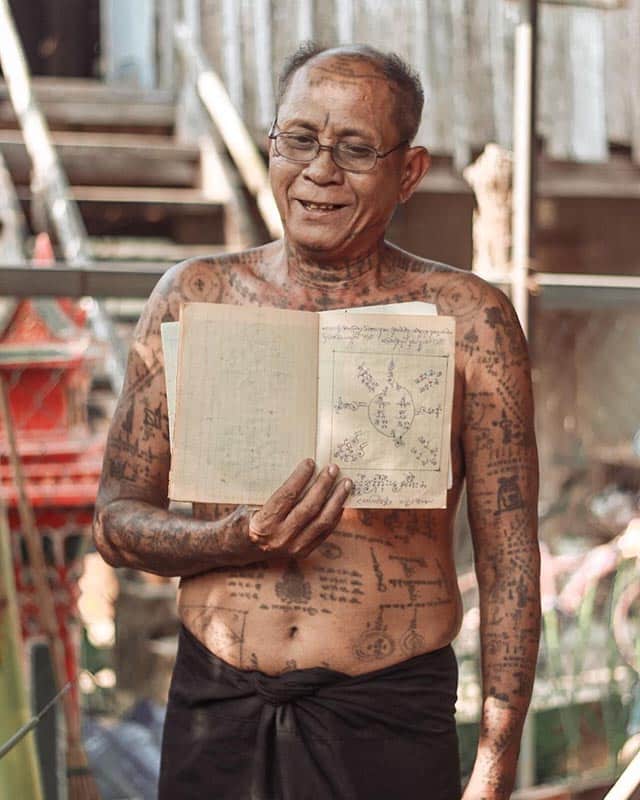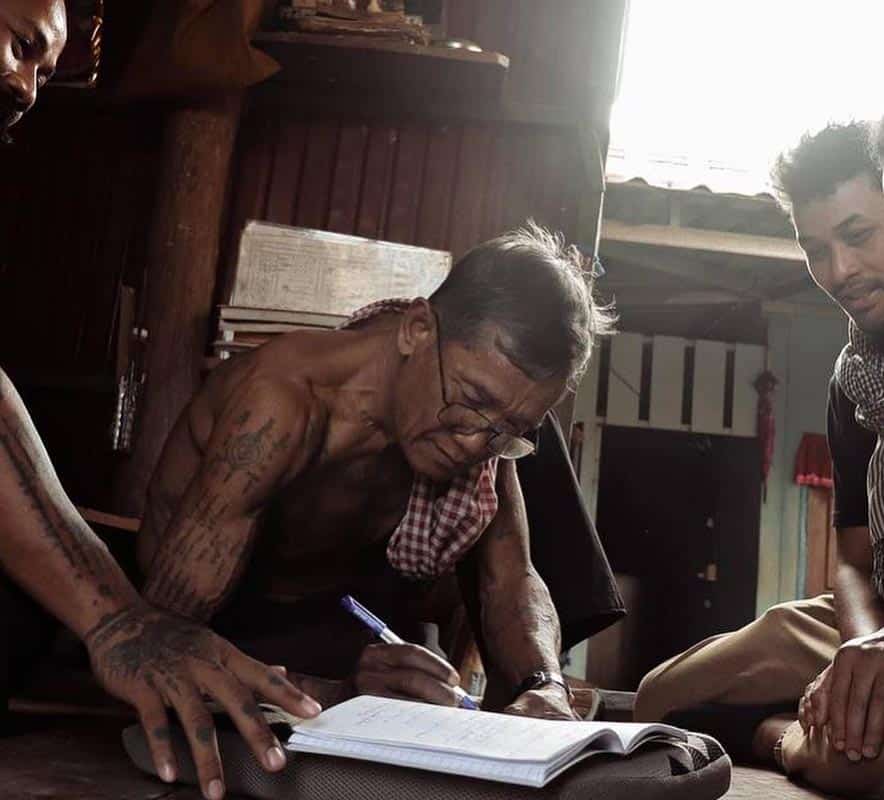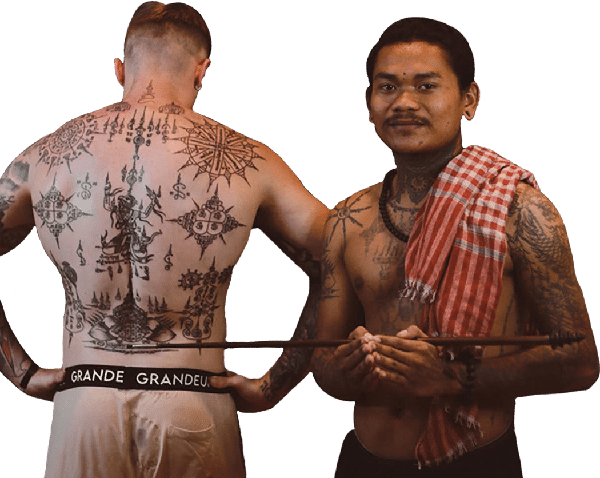
EXPERIENCE THE POWER OF KHMER SAKYANT IN THE HEART OF SIEM REAP

Book Your SakYant Experience Now
Khmer Tattoos: The Fusion of Buddhism, Hinduism, and Cultural Tradition
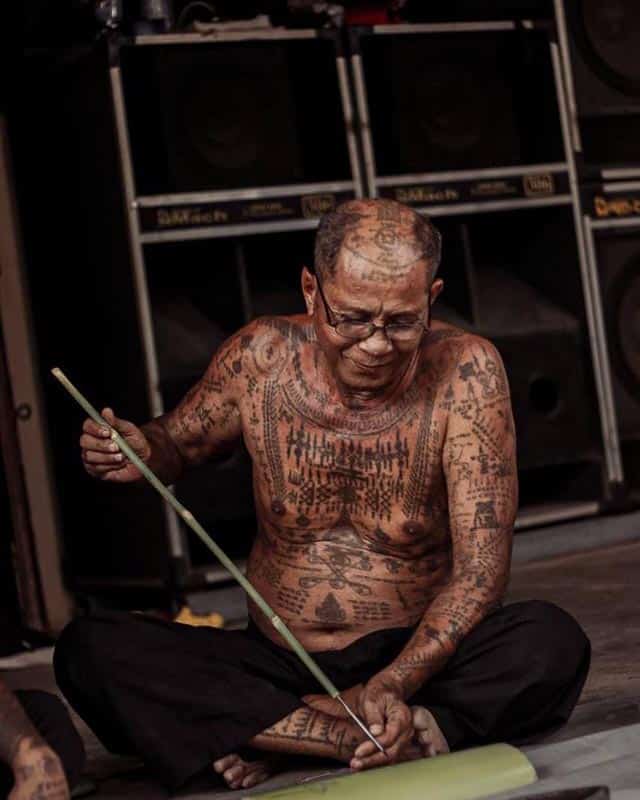
Allow me to share with you a glimpse into the rich heritage of the Khmer tattoo tradition. Rooted in the cultural tapestry of Cambodia, Khmer tattoos have a history that spans centuries, embodying spiritual significance and artistic prowess. In this article, we will delve into the captivating world of Khmer tattoos, exploring their origins, symbolism, and the artistic techniques employed in their creation.
From the intricate designs that tell ancient tales to the sacred rituals surrounding the tattooing process, we will uncover the essence of Khmer tattoos and their timeless allure. So, prepare to embark on a journey that celebrates the beauty of this ancient art form, as we unravel the mysteries of Khmer tattoos at Preservation Khmer SakYant.
History of Khmer Tattoo
The roots of Khmer tattoos can be traced back to the ancient civilizations of Cambodia. Historical references, etched in stone carvings and scriptures, offer glimpses into the significance of tattoos in Khmer culture. These artefacts reveal that tattoos were not merely decorative but held deep spiritual and cultural meanings.
In Khmer culture, tattoos are regarded as sacred marks, believed to bestow protection, blessings, and power upon the wearer. They are seen as a physical manifestation of spiritual beliefs and a means to honour deities and ancestors. During the ancient civilizations of Cambodia, Khmer tattoos were mostly worn by brave warriors, respected monks, and revered spiritual leaders, signifying their status and devotion.
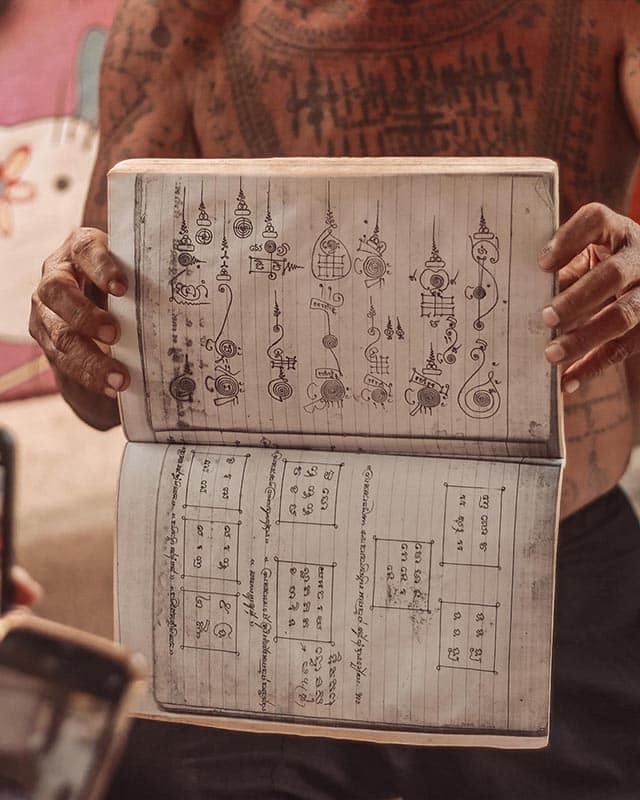
Evolution Over Time
Over the centuries, Khmer tattoos have undergone an evolution in design and symbolism. Initially, the designs primarily consisted of geometric patterns and animal motifs. However, as time passed, intricate mythological figures, deities, and sacred symbols found their way into Khmer tattoo designs. Each element held its own symbolic representation, contributing to the narrative and personal significance of the tattoo.
Influence of Buddhism and Hinduism
Buddhism and Hinduism played a pivotal role in shaping the evolution of Khmer tattoos. As these religious traditions took root in Cambodia, they infused their symbolism into the tattoo designs. Images of deities like Naga, Garuda, and Hanuman became prevalent, representing various virtues and spiritual beliefs. The merging of these religious elements with traditional Khmer tattooing techniques created a unique fusion that continues to define Khmer tattoos today.
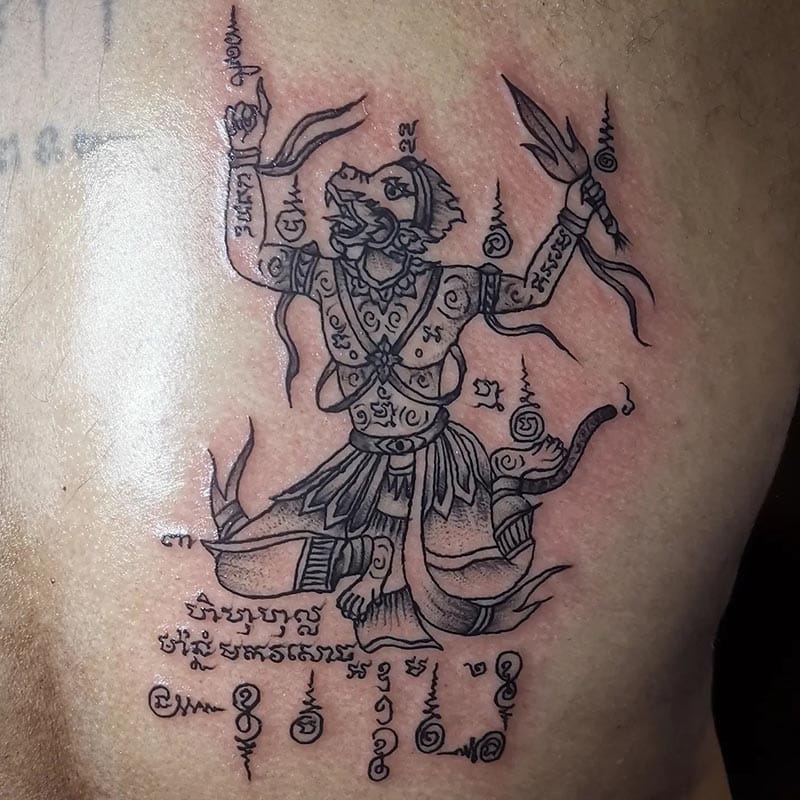
Significance and Symbolism of Khmer Tattoos
Khmer tattoos are imbued with profound symbolism and beliefs that hold great significance in the lives of wearers. One primary aspect is the notion of protection and luck. These designs are believed to serve as powerful guardians, shielding the wearer from harm and attracting good fortune.
Understanding Common Khmer Tattoo Symbols
Animals
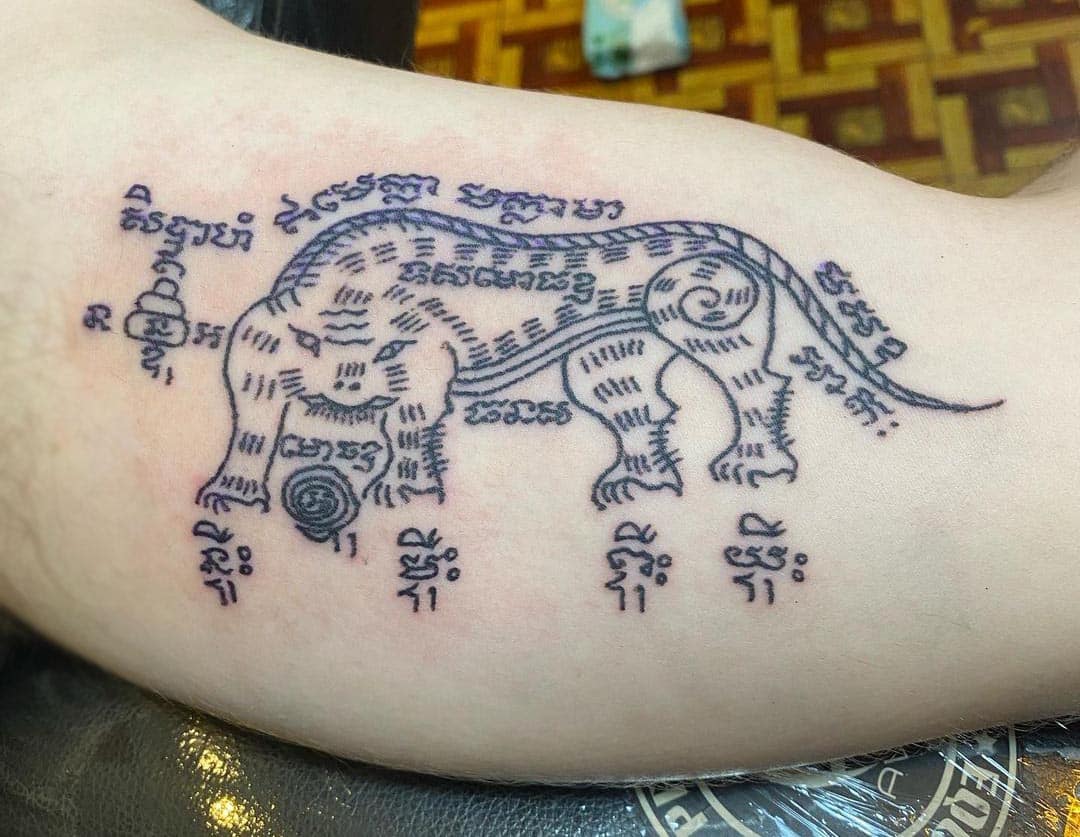
Animals hold significant symbolism in Khmer tattoo designs. Each creature represents unique qualities and virtues. Animals like tigers, birds, turtles and many others are also commonly depicted.
Deities and Mythological Figures
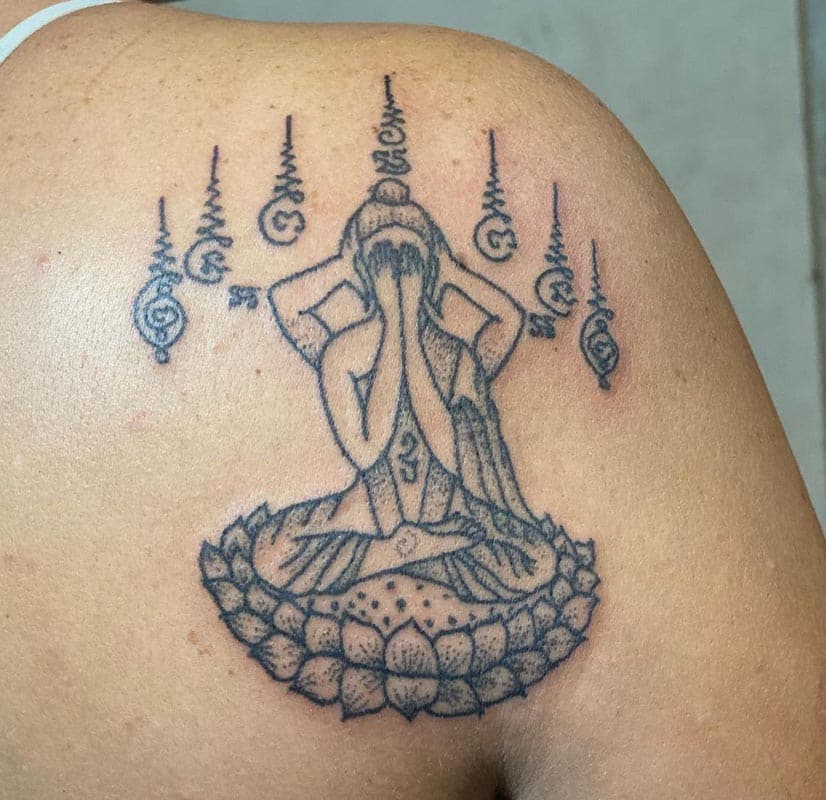
Deities and mythological figures play a prominent role in Khmer tattoo symbolism. Each deity carries its own virtues and attributes.
Scripts and Sacred Geometry
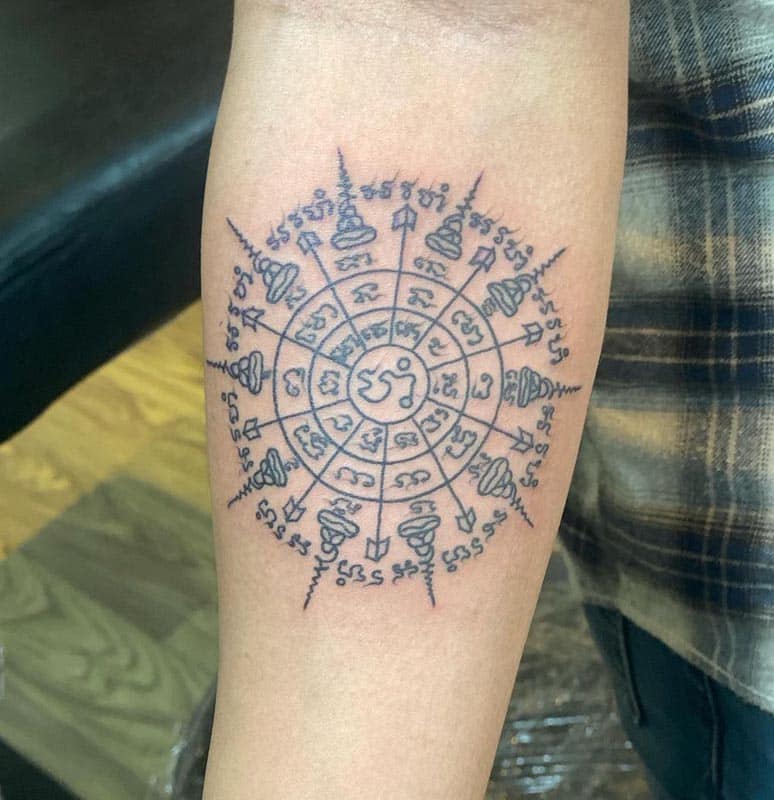
Khmer tattoos often incorporate ancient scripts and sacred geometry, adding layers of meaning and mystique to the designs. Yantra are commonly used to convey profound messages or invoke specific energies.
Process of Getting a Khmer Tattoo
Role of the Tattoo Master (Ajaa)

The role of the Tattoo Master, known as Ajaa, is of utmost importance in the process of getting a Khmer tattoo. Ajaa is not just an artist, but also a spiritual guide, entrusted with the responsibility of preserving the sacred traditions and bestowing blessings upon the wearer. The Ajaa possess extensive knowledge of Khmer tattoo symbolism and rituals, ensuring that each tattoo carries the intended spiritual essence and protection.
This ceremony is a vital aspect of Khmer tattooing, as it infuses the tattoo with spiritual power and protection. To perform the blessing, the Ajaa gathers seven different types of fruits, ten lotus flowers, one pack of incense, five candles, and one pack of cigarettes. These items represent offerings and symbols of reverence in the blessing ritual, enhancing the spiritual connection between the tattoo, the wearer, and the divine forces.
The Sak Yant Tattooing Technique

The Sak Yant tattooing technique used at Preservation Khmer SakYant follows the traditional practices of Khmer tattooing. The bamboo technique allows for precise control and enables the Ajaa to create intricate and detailed designs.
Pain and healing process
The process of getting a Khmer tattoo, like any other tattoo, involves some level of discomfort. The Ajaa, with their expertise, ensures that the process is carried out with care and mindfulness, minimizing discomfort as much as possible. However, the pain experienced during the Sak Yant tattooing process is, despite initial assumptions, considerably less painful than a modern tattoo gun.
After the tattooing is complete, proper aftercare is crucial for optimal healing. The Tattoo Master will provide detailed instructions on how to care for the tattoo, including keeping it clean, avoiding excessive sun exposure, and applying healing ointments.
Understanding the sacredness of Khmer tattoos
As Khmer tattoos gain popularity among tourists visiting Cambodia, it is essential to understand their sacredness. These tattoos hold profound cultural and spiritual significance for the Khmer people. Visitors should approach Khmer tattoos with reverence, recognizing that they are not merely fashion statements but deeply rooted in centuries-old traditions and beliefs. It is important to seek out reputable tattoo studios, like Preservation Khmer SakYant, that prioritize cultural preservation and authenticity.
For tourists considering getting Khmer tattoos, it is crucial to approach the process with ethical considerations in mind. Engaging in responsible tattoo tourism means actively supporting local artists and respecting the cultural context of the tattoo. Prioritize studios that work closely with the Khmer community, uphold traditional techniques, and ensure the appropriate spiritual rituals are observed. Additionally, engage in open and respectful communication with the Tattoo Master, allowing them to guide you in choosing a design that aligns with the sacred symbolism and cultural heritage of Khmer tattoos.

Why Choosing Preservation Khmer Sak Yant for Your Khmer Tattoo
Expertise and Authenticity
After years of continual learning with the few last Sak Yant masters in Cambodia, We possess an in-depth understanding of Khmer tattoo symbolism, cultural traditions, and the spiritual significance behind each design. You can trust that your Khmer tattoo will be expertly crafted, ensuring authenticity and a result that truly reflects the essence of this ancient and traditional art form.

Commitment to Traditional Methods
We remain committed to preserving the traditional methods of Khmer tattooing. We utilize authentic tools and techniques passed down through generations, such as the bamboo stick and the precise hand-tapping method called "Sak Bok Dai". By adhering to these time-honoured practices, we maintain the integrity and authenticity of Khmer tattoos, ensuring that each design carries the cultural and spiritual significance it deserves.
Respect for Cultural Heritage
We understand the cultural importance of Khmer tattoos and the need to safeguard this ancient tradition. Through my work, we strive to the preservation of Khmer tattoo art by honouring the symbolism, maintaining traditional techniques, and upholding the sacred rituals associated with the tattoos.
Book your meeting at Preservation Khmer Sak Yant and embark on a journey that transcends borders and time, as we celebrate the significance and beauty of Khmer tattoos together. Send us a message on Instagram or on WhatsApp at +855 96 694 5501. Let your body become a canvas for the cultural heritage, spiritual blessings, and artistic excellence that define this remarkable tradition.
